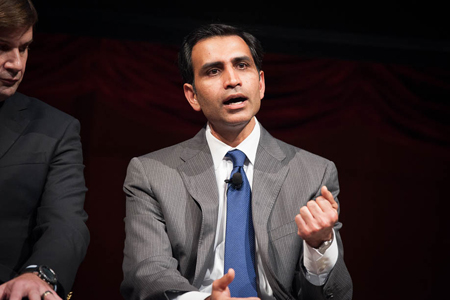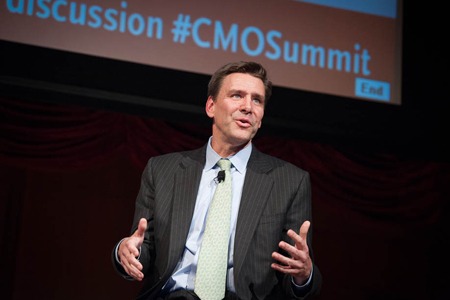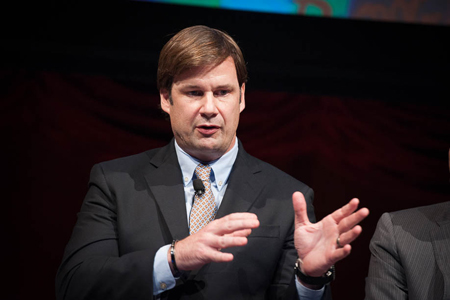Never before have marketers had so much data from so many sources at their disposal, or the sophisticated tools and technology to collect, analyze and make use of that data. Nevertheless, most marketers would admit that their organizations have a long way to go before they could be considered sophisticated users of “big data.”
View video highlights from the 2013 CMO Summit panel discussion.
See the results of this year’s CMO Summit survey, revealing the views of 171 U.S.-based marketing executives on big data and related talent needs.
The 2013 Spencer Stuart CMO Summit, held May 2 in New York City, explored how marketers are using big data today and how the marketing function will continue to evolve in light of the growing use of data and sophisticated analytics tools. Now in its 11th year, Spencer Stuart’s CMO Summit is an annual gathering of top marketers to discuss the most timely business issues of the day. The event draws marketers representing a broad cross-section of industry sectors.
This year, the CMO Summit panel featured Jim Farley, executive vice president of global marketing, sales and service, and Lincoln for Ford Motor Company; Sanjay Gupta, executive vice president of marketing, innovation and corporate relations for Allstate Insurance Company; and John L. Kennedy, vice president of corporate marketing for IBM Corporation. Below are a few highlights from the discussion:
- Data analysis in marketing is not new, but the volume and nature of data has changed dramatically in recent years. The “big” in big data refers not just the proliferation of data that is available, but also to the variety of that data, a growing percent of which is unstructured — tweets, emails, video, audio, call center transcripts, etc. — rather the structured, often transactional data housed in traditional databases. And much of this data can be characterized as “fuzzy because its accuracy cannot be confirmed. At the same time, the ability to process and analyze unstructured data has increased dramatically. Powerful computing systems can process data much faster, and, in some cases, provide useful insights in real time. Over time, panelists said, organizations that are sophisticated in their use of data will win.
- While the use of analytics for designing and making adjustments to digital marketing campaigns is well-established, more than half of marketers in the audience indicated that they are using insights from data beyond the tactical to help shape their core marketing strategies. In one example presented during the discussion, a company used insights gleaned from social media to create “archetypes” of customers around whom products or features can be designed.
- Smaller organizations also can leverage big data, despite their relative lack of scale and resources. For example, a city zoo with about $30 million in annual revenues was able to standardize and analyze data it already collected, including ticket sales, membership data, merchandise and food sales, and weather data, to make observations — such as the temperature that beer is most likely to bought and the times of the day when ice cream sales are strong — that influenced operational changes that improved sales.

- As increasingly more specific detail about individuals and their behavior becomes available to marketers, judgment and principles will have to guide organizations as they make decisions about how to use data. Marketers who do right by the customer and consider carefully how their use of data reflects the company’s brand and values will be in a better position to earn customers’ trust. Similarly, organizations will have to decide how much to share with partners in order to improve the customer experience in line customers’ expectations about the use of personal data.
- A persistent challenge for increasing the use of big data tools and techniques is their complexity and “black box” nature, which can make it difficult to trust and understand the output of big data approaches and to convince others of the value and accuracy of the insights the tools produce. Big data initiatives that are focused on the customer are more likely to win support from the C-suite, panelists said. Furthermore, marketers can reduce the mystery around big data — and increase buy-in — by collaborating with other functional leaders on the questions the organization should be trying to answer with data and creating transparency around the process.
- Panelists cautioned that there are no shortcuts or one-size-fits-all packages for big data. Effectively using data requires a great deal of upfront work, including defining what the organization wants to learn, designing the right approaches and standardizing data across functions so that different sets of data can be compared and connections can be made.

- Effective marketing still relies on storytelling, and marketers should not allow data to dictate those stories. Marketing will continue to be a source of ideas and inspiration, but data may provide clues to help trigger new ideas, and it can help marketers improve the execution of marketing programs.
- The rise of “modern” digital marketing and big data is driving close ties between the CMO and the chief information officer in sophisticated companies. “The marketing discipline is so rooted in data and technology now, I find in at least half of my meetings, there is someone from technology present,” said one panelist.
- Organizations that want to increase their use of big data will continue to need specialists in data analytics and data science. As the use of big data grows, the data literacy of marketers and others across the business must increase, and marketing no longer can be the refuge for those who don’t like math. More and more, marketers will have to be prepared to identify the right questions to ask and have the technical skills to execute digital and data-driven programs. Academic institutions and training programs can take some of the fear away by building a basic understanding of data and analytics tools.

- Highly transactional industries that have direct relationships with their customers, such as e-commerce and financial services, have moved more quickly to adopt big data tools and evolve their teams, bringing in specialists in analytics and behavioral sciences, in order to get more out of the data. In a poll of CMO Summit audience members, nearly three-quarters indicated that their marketing team lacks the right talent to leverage big data.
- Analytics specialists increasingly will be embedded within functional disciplines, including marketing, supply chain, finance and human resources, because each has data uniquely useful to its work. However, the organizations that are best able to see patterns across disciplines and use them to improve the business are the ones that will be most successful in their use of data.